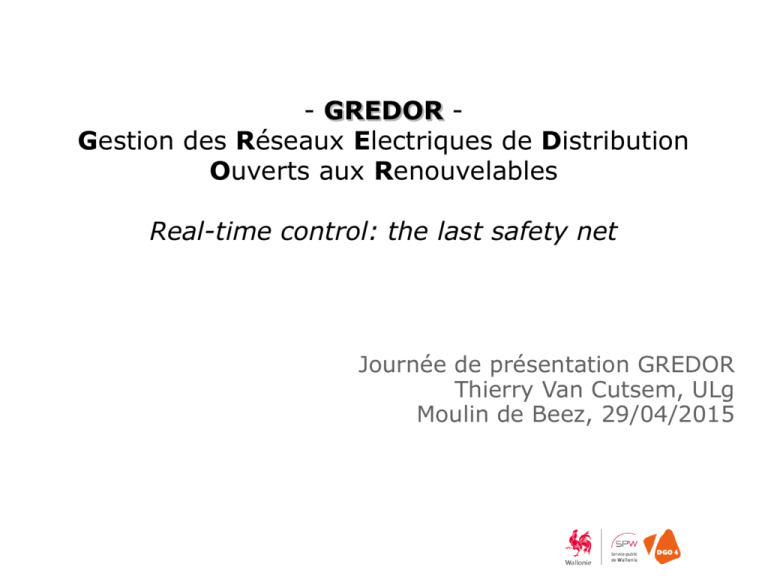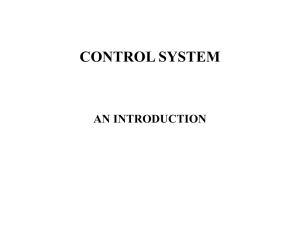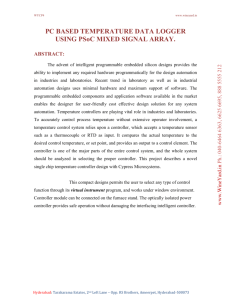set-points
advertisement

- GREDOR Gestion des Réseaux Electriques de Distribution Ouverts aux Renouvelables Real-time control: the last safety net Journée de présentation GREDOR Thierry Van Cutsem, ULg Moulin de Beez, 29/04/2015 Context (1/3) Distribution networks are expected to host larger amounts of dispersed renewable generation voltage and congestion (thermal overload) problems are expected to occur more often but, hopefully, over limited periods of time Test system with: • 75 MV buses • 22 DG units (doubly fed induction & small synchronous generators) 2 Context (2/3) Reinforcing the network (“fit-and-forget”) to deal with such temporary problems would be too expensive there is a good opportunity to use Distributed Generation (DG) units as “control means” to remove the security limit violations this is a service for which DG unit operators/owners could be financially compensated Loads with new consumption profiles see Task 1 of GREDOR e.g. electric vehicles, heat pumps, etc. Flexible loads are expected to also provide control means through remote control, complementing smart meters this presentation, however, focuses on DG units only. 3 Context (3/3) Automatic control schemes are needed to assist the Distribution System Operator in: correcting voltage and/or congestion emergencies keeping the MV grids within desired operating limits coordinating their actions with transmission system operator 4 Desired features of automatic corrective control Centralized control with system-wide monitoring and model preferred exploit less expensive controls first requires a communication infrastructure… …but offers more advanced control capabilities …and communication cost will be much lower than network reinforcement e.g. reactive power modulation preferred to active power curtailment act in a non discriminatory and transparent manner optimize a system-wide objective with efforts shared by all relevant DG units drive the system from the current (unacceptable) to the desired (secure) operating point do not rely on models which may not be available / accurate especially for loads (sensitivity to voltage not well known !) rely on a simplified model (e.g. infrequently updated) be robust with respect to inaccuracies of this simplified model 5 Centralized controller: inputs and outputs (volt. set-point of load tap changer) V controller P, Q , V measurements P, Q (refreshed every ~ 10 s) set-points P, Q , V (updated every ~ 10 s) P, Q P, Q , V P, Q 6 Model Predictive Control At time 𝑘, the controller : uses the last measurements and a model of the system to predict its response at 𝑁𝑝 future times computes an optimal sequence of 𝑁𝑐 future controls (𝑁𝑐 ≤ 𝑁𝑝 ) applies the first component only. At time 𝑘 + 1 , the whole procedure is repeated. predicted output measurement 𝑘 𝑘 + 𝑁𝑝 𝑘+1 discrete time computed set-point (sent to DG unit) discrete time 𝑘 𝑘+1 𝑘 + 𝑁𝑐 7 Mode 1 static data measurements Network data set points DSO : Distribution System Operator DSO State estimation Controller ∆𝑷 ∆𝑸 Real-time measurements Local controller 𝑃 𝑚𝑒𝑎𝑠 𝑄 𝑚𝑒𝑎𝑠 𝑉 𝑚𝑒𝑎𝑠 𝑷,𝑸 Non Dispatchable MPPT DG units MPPT : MaximumPower Point Tracking 8 Mode 2 static data measurements Decision by non-DSO actor DSO State estimation Real-time measurements 𝑃 𝑚𝑒𝑎𝑠 𝑄 𝑚𝑒𝑎𝑠 𝑉 𝑚𝑒𝑎𝑠 Corrective reports Network data set points Controller DSO : Distribution System Operator ∆𝑷 ∆𝑸 𝑷 ,𝑸 Dispatchable DG units 9 Test system 22 DG units controlled controls adjusted every 10 s Nc = 3 Np = 3 (larger if LTC actions anticipated) 10 Example 1 Mode 1. Wind increase (t = 20 → 70 s, all 22 wind generators) Congestion corrected by controller 11 Mode 3.a static data Decision by non-DSO actor measurements set points Network data State estimation Real-time measurements 𝑃 𝑚𝑒𝑎𝑠 𝑄 𝑚𝑒𝑎𝑠 𝑉 𝑚𝑒𝑎𝑠 𝑷 ,𝑸 DSO Corrective reports information Controller 0 near-future schedule ∆𝑷 ∆𝑸 𝑷 ,𝑸 DG units 12 Mode 3.b Operational planning Network data State estimation Real-time measurements 𝑷 ,𝑸 set points information Corrective reports DSO static data measurements 0 near-future schedule Controller ∆𝑷 ∆𝑸 𝑷 ,𝑸 𝑃 𝑚𝑒𝑎𝑠 𝑄 𝑚𝑒𝑎𝑠 𝑉 𝑚𝑒𝑎𝑠 DG units 13 Example 2 Mode 1 : 9 generators - wind increase (t= 20 → 70 s) Mode 3 : 13 generators - power schedule (t= 150 → 180 s) Overvoltages corrected by controller generation schedule 14 Overview of various modes Mode 1 Mode 2 Modes 3a & 3b DG units Control strategy nondispatchable Normal operating conditions: take no corrective action dispatched by non-DSO actor Emergency conditions: deviate as few as possible from the last normal operating conditions both dispatchable and nondispatchable Normal operating conditions: control system to follow the schedule Emergency conditions: deviate as few as possible from the schedule Capability of anticipating limit violation ? No. Correction is applied after violation is observed Yes. Controls are applied to avoid exceeding the limits 15 Summary Centralized controller collecting measurements and adjusting set-points of DG units to satisfy operating constraints: currents below limits voltages inside bounds power factor at connection point with transmission system relies on concept of Model Predictive Control moving the operating point progressively from current to desired state compensating for modelling inaccuracies (as a closed-loop control) anticipating the effect of known changes (Modes 3.a & 3.b) uses a simple, infrequently updated sensitivity model takes into account the load tap changer operation as a separate controller or by controlling its voltage set-point constrained optimization problem compatible with real-time operation 16 Ongoing work in GREDOR Extensions of formulation treat discrete controls as such in optimization reset DG units at maximum / scheduled power after emergency situation has been corrected and operating conditions improve treat flexible loads and storage devices as additional control variables mitigate high voltage problems in LV grid due to photo-voltaic installations etc. Implementation aspects and further tests Assess practical telecommunication needs Provide more meaningful results with the networks of GREDOR DSO partners Further integration with Task 3 (operational planning) and Task 1 (interactions) etc. 17







